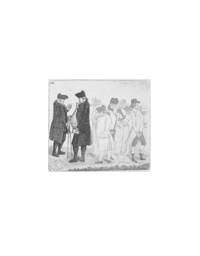Annotation:Mrs. Rigg
Back to Mrs. Rigg
MRS. RIGG. Scottish, Jig. G Minor. Standard tuning (fiddle). AAB. Composed by Nathaniel Gow (1763-1831).
The following sketch of Mrs. Rigg and her husband is recorded in John Kay's A series of original portraits and caricature etchings. With biographical sketches and illustrative anecdotes (1877, pp. 147-150):

The first individual portrayed in this Print is JAMES HUME RIGG of Morton. His name was originally Rigg, that of Hume having been assumed on obtaining, by the death of a relative, the estate of Gammelshiels, in Haddingtonshire. He succeeded his elder brother, Thomas Rigg, in the estate of Morton about the year 1780.
Mr. Rigg was an extensive shareholder in the Bank of Scotland, or "Old Bank," as it was commonly called; but, although possessed of a very ample fortune, it was rumoured that he was somewhat parsimonious. The young lady whom he married — a sister of the late Sir John Sinclair of Ulbster — being of a more liberal disposition, it frequently happened that their opinions in matters of fashion and etiquette were very widely at variance ; and at no time was her lord and husband more fretful than when the annual accounts for dress came to he presented.
It is said that Dr. Gloag, one of the ministers of Edinburgh, was on one occasion invited to the house of Mr. Rigg to dinner. He was entertained in a plain but very substantial manner. On taking leave, he was pressed by the lady to repeat his visit a few days afterwards. "This," said she, "is one of Mr. Hume's quiet affairs; the next will be mine!" Dr. Gloag kept his appointment; and was astonished to find himself one of a large party, for whom a sumptuous dinner had been prepared, in a style of splendour, and with an array of waiting-men, for which he was little prepared.
Mr. Rigg had no children to inherit his wealth--a circumstance which grieved him deeply; and, by a will, supposed to have been made in one of his fretful moods, a short time before his demise, he left only a small jointure to his widow. He died at his house, in Gosford's Close (now removed to make way for George the Fourth Bridge), on the 23d January 1788--a month which had been fatal to his grandfather, father, and elder brother. Patrick Rigg, Esq., of Dounfield and Tarvit, succeeded to the whole of his property.
Mrs. Rigg was altogether a lady of uncommon vivacity and gaiety of spirit; and her youthful fancies were not easily sobered down to the quiet, cool, domestic enjoyments of mature age. Skilled in all the feminine accomplishments, her lively temper embraced others of a more masculine character. She was one of the most agile and graceful dancers of the age, and an excellent violin player; and has been known frequently to accompany her movements on "the light fantastic toe" by the inspiring strains of her own cremona.
A description of Mr. Rigg's house, which was situated at the bottom of the close, may furnish an idea of the taste and fashion of the "olden time." The dining and drawing-rooms were spacious and lofty; indeed, more so than those of any private modern house we have ever seen. The bedrooms were proportionally large and elegant. The lobbies were all variegated marble, and a splendid mahogany staircase led to the upper story. There was a large garden behind, with a statue in the middle, and at the bottom was a summer-house; but such was the confined entry to this elegant mansion, that it was impossible even to get a sedan chair near to the door.
A sister of Mr. Hume Rigg — Miss Mally — who resided in a house adjacent to her brother, was killed by the falling in of a chimney during the violent hurricane 20th January 1773. The storm, which began early in the morning, was described in the journals of the day as the severest that had occurred since the windy January 1739. "About half an hour' after four, a stack of chimneys on an old house at the foot of Gosford's Close, Lawnmarket, possessed by Mr. Hugh Mossman, writer, was blown down ; and, breaking through the roof in that part of the house where he and his spouse lay, they both perished in the ruins, but their children were providentially saved. In the story below, Miss Mally Rigg, sister to Mr. Rigg of Morton, also perished."
He left several children, who inherited his wealth.
Source for notated version:
Printed sources: Carlin (The Gow Collection), 1986; No. 362. Gow (Fifth Collection of Strathspey Reels), 1809; p. 29. Laybourn (Köhler’s Violin Repository vol. 2), 1881-1885; p. 128.
Recorded sources:
